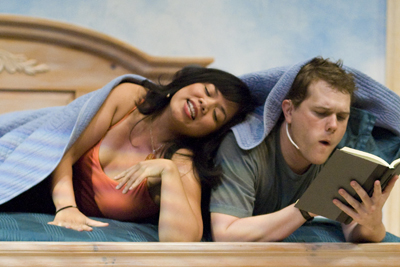|
By Carol Davis
 SAN DIEGO-The musical play Long Story Short based on the stage play An Infinite Ache by David Schulner that is marking the opening of the San Diego Repertory Theatre’s 34th season is the creative work of husband and wife team Brendan Milburn and Valerie Vigoda of the GrooveLily band fame. For a fleeting moment I thought I was watching The Four Poster, Jan de Hartog’s two-person play that traces Agnes and Michael’s marriage, rather than Charles and Hope’s journey. That too was later made into a musical I Do I Do with book and lyrics by Tom Jones and music by Harvey Schmidt. SAN DIEGO-The musical play Long Story Short based on the stage play An Infinite Ache by David Schulner that is marking the opening of the San Diego Repertory Theatre’s 34th season is the creative work of husband and wife team Brendan Milburn and Valerie Vigoda of the GrooveLily band fame. For a fleeting moment I thought I was watching The Four Poster, Jan de Hartog’s two-person play that traces Agnes and Michael’s marriage, rather than Charles and Hope’s journey. That too was later made into a musical I Do I Do with book and lyrics by Tom Jones and music by Harvey Schmidt.
B’Shert: destiny; one’s divinely foreordained spouse or soul mate.
In the Milburn/Vigoda musical Long Story Short a nice Jewish guy Charles (Robert Brewer) falls in love with an Asian American gal Hope (Melody Butiu) and live …well. This is not the stuff of which fairy tales are made nor is it as sugar coated as The Four Poster. Call it B’Shert, but just because something may be pre ordained doesn’t make it easy or soften the blows of a long-term relationship and that’s the point in Long Story Short.
The saying that opposites attract is dubious at times, but we do see it happening more and more. Take the case of Hope and Charles. Hope is an LA kind of gal, hip, professional and single and Charles; well he’s from the east coast, kind of nerdy and needy with no real job prospects in sight; he works in a coffee shop and might some day want to write an imaginary historical novel. Their backgrounds couldn’t be more different in every sense. Sounds all too familiar, but just a few years ago this inter racial, if you will, relationship would have been doomed from the start. In some Jewish quarters it still is, that is unless conversion is the end result.
(Just recently a judge in New Orleans refused to marry an inter-racial couple stating that any children of that marriage would suffer if the couple divorced. There’s a new one for you!)
Be that as it may, the two meet on a blind date and find themselves back at Charles’ one bedroom apartment (Victoria Petrovich designed a set that can be expanded in the small Lyceum Space) where Hope hopes to sleep off her wooziness for ‘just an hour’, with hopes that Charles will wake her and send her home. (It’s Really Getting Late) While she sleeps, he imagines a life together with her.
What follows is a cleverly crafted set of life circumstances that propel this musical love story forward with all the anticipation of one who might want to look into the future to see how their relationship may or may not look after a fifty or so year commitment. It’s smart, witty, edgy and sharp and holds your attention throughout. It’s true because it draws on real life experiences.
Vigoda, the daughter and granddaughter of two accomplished musicians, carries out the family tradition with her musicality, but miles away from her grandfather’s roots. Samuel Vigoda was a Hungarian born Jew and was one of the last great European cantors of the Golden Age whose father before him was the Chazan/Shochet. His last big concert was to ‘a mob of mostly Orthodox Jewish fans.'
Valerie’s father is an accomplished pianist who has accompanied both his father and daughter and considers himself ‘a link between the two.' Vigoda is an accomplished violinist as well. She and hubby founded the band GrooveLily in 1994 where she plays a six-string violin hybrid called the Viper while singing. Her life partner Brendan Milburn writes most of their music and plays the keyboard with the band. Together they make great music, I’m assuming great kids (they have a 3 ½ Mose) and write great stories with music.
Long Story Short is that story's musical. It travels through time seamlessly as the two, Charles and Hope, wind their way through a long term marriage that hits its highs and lows and ends up on pretty firm ground, but not without taking prisoners, as most long term relationships do. Under the deft direction of Kent Nicholson and with a finely tuned live five piece band playing above the stage, Charles and Hope muddle through the agonies of learning about each other, being not particularly happy about what they find all the time, loving each other, growing both financially and personally, raising a child, losing a child, trying to make it alone to a final reconciliation of celebrating what they have.
It’s a touching love story made all the more credible by the fine acting of both Butiu (seen a few years ago at South Coast Repertory Theatre in Donald Margulies’ Shipwrecked) and Brewer. Each has a distinct quality that carries throughout. Brewer is simply the guy next door a little paunchy but cute and convincing while Butiu is bit more complicated and exotic as she drives herself and her husband to be more than he aspires. In a desperate exchange about how to treat their errant daughter whom they are about to disown, they come up with the idea of moving away and not telling her. (That drew more than a few laughs).
Go to the top of next column |
|

.
With the action going back and fourth some clever dialogue thrown in between the songs that actually move the story, each has his/her work cut out but the acting is so darn good and real it works. The combination of body language, facial expressions, solid voices and great material makes the end result more than satisfactory.
Toby Ahrens on percussion, Victoria Bietz on violin, piano, Mark Danisovszky (he’s also the musical conductor), Diana Elledge on cello and Oliver Shirley on bass bang out about eighteen or so tunes like "We Should Get Married," "Let Me Hold Him," "Empowered," "Still Love" and "Letting Go."
The bed on Victoria Petrovich’s set is almost a third character in the play. It starts out as a simple antique bed Charles brought all the way from the east coast. It belonged in his family “and stays with him." It almost fills his one bedroom apartment as the story begins and becomes the focal point of the show as it is moved from corner wall to holding a place of prominence in every scene change, with some new bedcover looks along the way, as the couple becomes financially secure enough to live in larger spaces. M. Scott Grabau’s lighting adds the needed atmosphere to the picture as time and moods change. Chris Luessman’s sound design and Kate Stallons costumes give the piece a complete look.
It well worth a try. I highly recommend it.
Long Story Short continues through Nov. 1. For more information visit www.sdrep.org
The San Diego Repertory Theatre has planned a series of events and discussions to follow or precede certain performances. One such event is called “Why do Jewish people love Chinese Food?” It takes place Oct.29 at 7PM before the show.
Dr. Joellyn Zollman, who happens to be client at my daughters hair salon and someone with whom I have struck up a friendship, agreed to tell me more about her talk on Chinese food. I concluded that anyone who has a dog named Pumpernickel has earned the right to gab about food.
Joellyn is a frequent lecturer in the History Department at SDSU and specializes in Jewish art and Jewish history and was the Community editor of MyJewishLearning.com. She holds a PhD in Jewish History from Brandeis University in Boston and what caught my eye was her favorite restaurant in Brookline, Chef Chang’s House. Having lived in Brookline for four years while attending Boston University and later Boston Teachers College, I thought we could compare notes but it was not B’Shert. That restaurant wasn’t there in my day, drat!!!!!!
My late husband Gerry and I used to go a place called ‘The Cathay House’, if memory serves. He never could get over the fact that the Chinese food here in San Diego did not taste like the Chinese food there but that never stopped him from eating Chinese food. He was a Chinese food junkie like so many other Jews as witnessed by the interest this talk has generated.
Of course it helps that along with Joellyn speaking, kosher caterer Charles Rubin, who has provided Kosher Catering in South Africa and throughout San Diego will be offering tastes that night. Bete’avon.
Joellyn sent me a sample of some of what she will be saying. It sounds like fun. Savor the night.
Here's a "taste" of what I'm going to talk about on 10/29:
American Jews have an affinity for Chinese food that is motivated, in part, by the idea that Chinese is "safe treyf." From the early decades of the 20th century, sociologists surmise that Chinese food was appealing to Jewish immigrants because 1) it uses virtually no dairy, therefore avoiding the milk and meat combination that was repulsive to many American Jews who came from a kosher background, even if they were no longer maintaining the dietary laws themselves and 2) most treyf ingredients, especially pork, were so finally minced as to be unrecognizable.
See you at the theatre.
|
|

